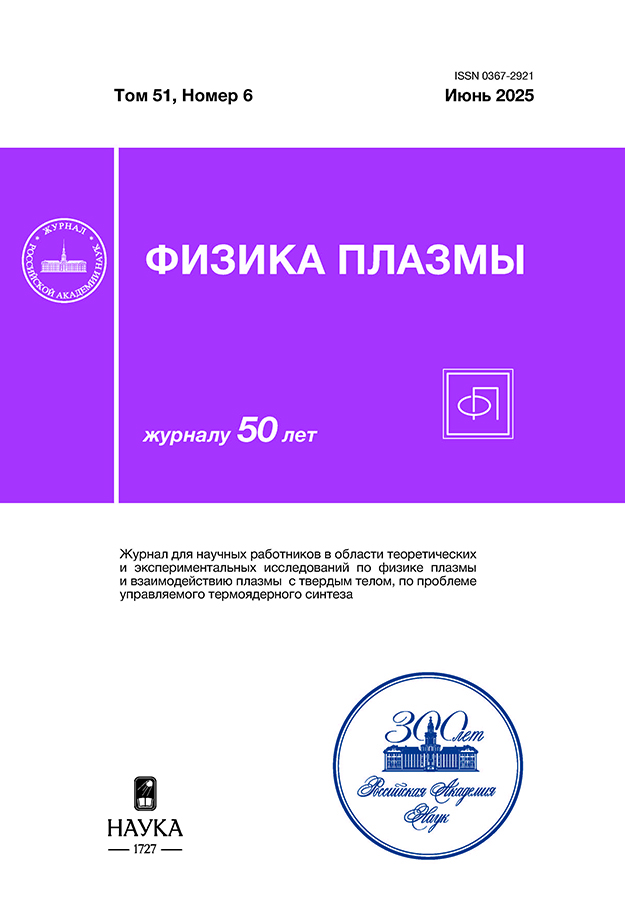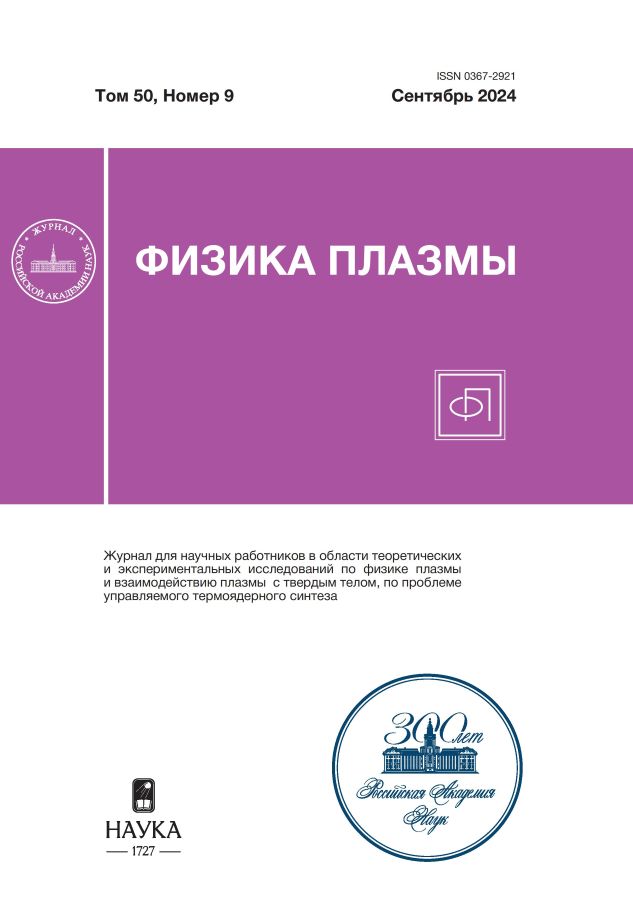Physical Principles and Main Research Results Determining the Development of Thrusters with Closed Electron Drift
- Authors: Kim V.P.1, Semenkin A.V.2, Shilov E.A.1
-
Affiliations:
- Research Institute of Applied Mechanics and Electrodynamics, Moscow Aviation Institute (National Research University)
- Keldysh Research Center, Roscosmos
- Issue: Vol 50, No 9 (2024)
- Pages: 1008-1061
- Section: PLASMA DYNAMICS
- URL: https://clinpractice.ru/0367-2921/article/view/683713
- DOI: https://doi.org/10.31857/S0367292124090032
- EDN: https://elibrary.ru/DVJLYB
- ID: 683713
Cite item
Abstract
The paper presents the results of many years of research carried out in various organizations of theUSSR and Russia in the process of developing thrusters with anode layer (TALs) and stationary plasmathrusters (SPTs). They are known under the general name “thrusters with closed electron drift” (TCEDs),since they are developed on the basis of plasma ion accelerators with closed electron drift (ACEDs). TCEDshave come a long way in development. As a result, the SPT has become one of the most widely used electricrocket thrusters (ERTs) and continues to develop. The TAL development has also reached a fairly high leveland is close to practical use. Therefore, here we consider the main physical principles and research results thatdetermined the progress in the SPT and TAL development with the aim of their analysis and generalization,as well as assessment of their applicability for further development such thrusters. A brief overview of the mainstages of the SPT and TAL development and the results achieved at these stages are given. It is shown that themain problem of their further development is to ensure both high thrust efficiency and a long service life. Itis also shown that the main factor limiting the service life of TALs and SPTs is the ingress of accelerated ionsonto their structure elements; therefore, in order to control the ion motion, it is first of all necessary to understandthe patterns of electric field formation in TCED discharges. New properties of TCED discharges andthe peculiarities of electric field formation are revealed and their known properties are clarified, which determinethe thickness and position of the acceleration zone with the main potential drop in the discharge andthe flows of accelerated ions onto the thruster structure elements. The methods of controlling the thicknessand position of the acceleration zone in an TCED by varying the magnetic field characteristics, successfullytested at the second stage of the SPT and TAL development, are considered and analyzed. It is shown thatthese methods make it possible to effectively control the operation of an TCED and its characteristics, andphysical conditions ensuring the efficiency of their application are determined. Physical conditions for theimplementation and justification of the feasibility of completely removing the acceleration zone from the thruster as the main direction of modern TCED development are determined, taking into account the analysis of the properties of the discharge and the peculiarities of electric field formation in an TCED. The main conclusions on the issues considered are given.
Full Text
About the authors
V. P. Kim
Research Institute of Applied Mechanics and Electrodynamics, Moscow Aviation Institute (National Research University)
Author for correspondence.
Email: riame4@mai.ru
Russian Federation, Moscow, 125993
A. V. Semenkin
Keldysh Research Center, Roscosmos
Email: riame4@mai.ru
Russian Federation, Moscow, 125438
E. A. Shilov
Research Institute of Applied Mechanics and Electrodynamics, Moscow Aviation Institute (National Research University)
Email: riame4@mai.ru
Russian Federation, Moscow, 125993
References
- Гришин С.Д., Ерофеев В.С., Жаринов А.В. Плазменные ускорители / Ред. Л.А. Арцимович. М.: Машиностроение, 1973. С. 54.
- Есипчук Ю.В. Плазменные ускорители / Ред. Л.А. Арцимович. М.: Машиностроение, 1973. С. 75.
- Гришин С.Д., Лесков Л.В., Козлов Н.П. Электрические ракетные двигатели. М.: Машиностроение, 1975. С. 272.
- Марахтанов М.К. Плазменные ускорители и ионные инжекторы / Ред. Н.П. Козлов и А.И. Морозов. М.: Наука, 1984. С. 264.
- Козубский К.Н., Мурашко В.М., Рылов Ю.П., Трифонов Ю.В., Ходненко В.П., Ким В.П., Попов Г.А., Обухов В.А. // Физика плазмы. 2003. Т. 29. С. 277.
- Kim V., Kozubsky K.N, Murashko V.M., Semenkin A.V. // Proc. 30th Internat. Electric Propulsion Confer. Florence, 2007. Paper IEPC-2007-142.
- Ким В.П., Семенкин А.В., Хартов С.А. Конструктивные и физические особенности двигателей с замкнутым дрейфом электронов. М.: МАИ, 2016.
- Юшманов E.E. Физика плазмы и проблемы управляемых термоядерных реакций / Ред. М.А. Леонтович. М.: АН СССР, 1958. Вып. 4. С. 235.
- Ерофеев В.С., Лесков Л.В. Физика и применение плазменных ускорителей / Ред. А.И. Морозов. Минск: Наука и техника, 1974. С. 18.
- Абдюханов В.А., Гришин С.Д., Ерофеев В.С., Жаринов А.В., Лесков Л.В., Ляпин Е.А., Наумкин В.П., Попов Ю.С., Сафронов И.Н. Ускорители ионов с анодным слоем (обзор). М.: ЦНИИМАШ, 1975. С. 5.
- Ерофеев В.С., Жаринов А.В., Ляпин Е.А. Плазменные ускорители / Ред. Л.А. Арцимович. М.: Машиностроение, 1973. С. 68.
- Гусев Ю.Г., Пильников А.В. // Электронный ж-л “Труды МАИ”. Вып. 60. www.mai.ru/science/trudy.
- Solodukhin A.E., Semenkin A.V., Tverdokhlebov S.O., Kochergin A.V. // Proc. 27th Internat. Electric Propulsion Confer. Pasadena, 2001. Paper IEPC-01-32.
- Garkusha V.I., Lebedev Y.V., Semenkin A.V., Zakharenkov L.E. // Proc. 29th Internat. Electric Propulsion Confer. Princeton, 2005. Paper IEPC-2005-185.
- Semenkin A.V. // Proc. 23rd Internat. Electric Propulsion Confer. Seattle, 1993. Paper IEPC 93-231.
- Семенкин А.В. Сборник научных трудов ЦНИИмаш. Королев., 2006. С. 93.
- Garkusha V., Kochergin A., Semenkin A. Tverdokhlebov S. // Proc. 25th Internat. Electric Propulsion Confer. Cleveland, 1997. Paper IEPC-1997-106.
- Semenkin A., Tverdokhlebov S., Solodukhin A., Zakharenkov L. // Proc. Internat. Electric Propulsion Confer. Florence, 2007. Paper IEPC-2007-128.
- Морозов А.И. Исследование стационарного электромагнитного ускорения плазмы: Дис. … д-ра физико-математич. наук. М.: ИАЭ им. И.В Курчатова, 1965.
- Морозов А.И. // ДАН. 1965. Т. 163. С. 1363.
- Salz А., Meyerand R., Lary E. // Bull. American Phys. Soc. 1962. Ser. 11. V. 8. P. 441.
- Seikel G., Reshotko E. // Bull. American Phys. Soc. 1962. Ser. 11. V. 7. P. 414.
- Lary C., Meyerand R.G., Glastonbury Jr., Salz F. // USA patent # 3 155 858. Nov. 3, 1964.
- Ким В.П. // ЖТФ. 2015. Т. 85. С. 45.
- Janes G.S., Dotson J. // Proc. 5-th Sympos. eng. aspects magnetohydrodynamics. Massachusets Inst. Techn., Camdridge, Mass. 1964. P. 235.
- Janes G., Lowder R. // Phys. Fluids. 1966. V. 9. P.1115.
- Арцимович Л.А., Андронов И.М., Есипчук Ю.В., Барсуков Н.А., Козубский К.Н., Левченко Ю.М., Михайличенко В.А., Морозов А.И., Петров Е.М., Романовский М.К.,, Рылов Ю.П., Снгарский Р.К., Тилинин Г.Н., Трифонов Ю.В., Трофимов А.В., Ходненко В.П., Шаров Ю.А., Щепкин Г.Я. // Космические исслед. 1974. Т. 12. С. 451.
- Архипов А.С., Ким В.П., Сидоренко Е.К. Стационарные плазменные двигатели Морозова. М.: МАИ, 2012.
- Морозов А.И. Плазменные ускорители / Под ред. Л.А. Арцимовича. М.: Машиностроение, 1973. С. 85.
- Морозов А.И., Есипчук Ю.В., Капулкин А.М., Невровский В.А., Смирнов В.А. // ЖТФ, 1973. Т.43. Вып. 5. С. 972.
- Ким В.П., Попов Г.А., Шилов Е.А., Козубский К.Н., Приданников С.Ю. // Космическая техника и технологии. 2023. № 4(43). С. 55.
- Dan L., Myers R.M., Lemmer K.M., Kolbeck J., Keidar M., Koizumi H., Liang H., Yu D., Schönherr T., del Amo J.G., Choe W., Albertoni R., Hoskins A., Yan Sh., Hart W., Hofer R.R., Funaki I., Lovtsov A., Polzin K., Olshanskii A., Duchemin O. IEPC-2017 // Proc. 35th Internat. Electric Propulsion Confer. Atlanta, 2017. Paper -242.
- Абраменков Г.В., Вертаков Н.М., Дронов П.А. Каплин М.А., Приданников С.Ю. // Космическая техника и технологии. 2023. № 4 (43). С. 36.
- Демьяненко В.Н., Зубков И.П., Лебедев С.В., Морозов А.И. Препринт ИАЭ. № 2934. М.: ИАЭ, 1967.
- Бугрова А.И., Версоцкий В.С., Харчевников В.К. // ЖТФ. 1980. Т. 50. С. 2238.
- Бишаев А.М., Ким В.П. // ЖТФ. 1978. Т. 48. С. 1853.
- Бишаев А.М., Ким В.П. // Источники и ускорители плазмы. Харьков: ХАИ, 1981. № 5. С. 3.
- Ким В.П. // Физика плазмы. 2017. Т. 43. С. 406.
- Морозов А.И. // ПМТФ.1968. № 3. С. 19.
- Егоров В.В., Ким В.П., Семенов А.А., Шкарбан И.И. Ионные инжекторы и плазменные ускорители / Ред. А.И. Морозов и Н.Н. Семашко. M.: Энергоатомиздат, 1990. С. 56.
- Морозов А.И., Есипчук Ю.В., Тилинин Г.Н, Трофимов А., Шаров Ю.А., Щепкин Г.Я. // ЖТФ. 1972. Т. 42. С. 54.
- Морозов А.И., Есипчук Ю.В., Капулкин А.М., Невровский В.А., Смирнов В.А. // ЖТФ. 1973. Т. 43. С. 972.
- Есипчук Ю.В., Тилинин Г.Н. // ЖТФ. 1976. Т. 46. С. 718.
- Тилинин Г.Н. // ЖТФ. 1977. Т. 47. С. 1684.
- Белан Н.В., Ким В.П., Оранский А.И., Тихонов В.Б. Стационарные плазменные двигатели. Харьков: ХАИ, 1989.
- Бугрова А.И., Ким В.П. Плазменные ускорители и ионные инжекторы / Ред. Н.П. Козлов и А.И. Морозов. М., 1984. С. 107.
- Кim V. // J. Propulsion Power. 1998. V. 14. P. 736.
- Приданников С.Ю. Исследование характеристик стационарных плазменных двигателей при длительной работе: Дис. … канд. технич. наук. Калининград: Российский государственный университет, 2003.
- Mitrofanova O.A., Gnizdor R.Yu. // Proc. 33rd Internat. Electric Propulsion Confer. Washington, D.C., 2013. Paper IEPC-2013-51.
- Ким В.П., Гниздор Р.Ю., Ермошкин Ю.М., Меркурьев Д.В., Приданников С. Ю. // Поверхность. 2018. № 3. С. 18.
- Гаркуша В.И., Лесков Л.В., Ляпин Е.А. Плазменные ускорители и ионные инжекторы / Ред. А.И. Морозов, Н.Н. Семашко. М.: Наука, 1984. С. 129.
- Ляпин Е.А., Семенкин А.В. Ионные инжекторы и плазменные ускорители / Ред. А.И. Морозов, Н.Н. Семашко. М.: Энергоатомиздат, 1990. С. 20.
- Семенкин А.В. // Космонавтика и ракетостроение. М.: ЦНИИМАШ, 2004. Вып. 1(34). С. 5.
- Mikellides I.G., Katz I, Hofer R.R, Goebel D.M., de Grys K., Mathers A. // Phys. Plasmas. 2011. V. 18. P. 033501.
- Hofer R., Kamhawi H., Herman D., Polk J., Snyder J, Mikellides I., Huang W., Myers J., Yim J., Williams G., Ortega A., Jorns B., Sekerak M., Griffiths Ch., Shastry R., Haag Th., Verhey T., Gilliam B., Katz I., Goebel D, Anderson J., Gilland J, Clayman L. // Proc. 30th Internat. Symp. Space Technology and Science and 34th Internat. Electric Propulsion Confer. and 6th Nano-satellite Symp. Kobe, 2015. Paper IEPC-2015-186 /ISTS-2015-b-186.
- Conversano R.W., Goebel D.M., Hofer R.R., Mikellides I.G., Katz I., Wirz R.E. // Proc. 30th Internat. Symp. Space Technology and Science and 34th Internat. Electric Propulsion Confer. and 6th Nano-satellite Symp. Kobe, 2015. Paper IEPC-2015-100/ISTS-2015-b-100.
- Ким В.П., Архипов А.С., А. М. Бишаев А. М., Меркурьев Д. В., Сидоренко Е. К. // Физика плазмы. 2014. Т. 40. С. 937.
- Lobbia R.B., Ortega A.L., Reilly S., Conversano R.W., Mikellides I.G. // Proc. 36th Internat. Electric Propulsion Confer. Vienna, 2019. Paper IEPC-2019-298.
- Морозов А.И. Плазменные ускорители / Ред. Л.А. Арцимович. М.: Машиностроение, 1973. С. 85.
- Janhunen S., Smolyakov A., Chapurin O., D. Sydorenko D., Kaganovich I., Raitses Ye. // Phys. Plasmas. 2018. V. 25. P. 011608.
- Boeuf P. // Phys. Plasmas. 2019. V. 26. P. 072113. doi: 10.1063/1.510216.
- Taccogna F., Garrigues L. // Revs. Modern Plasma Phys. 2019. V. 3. P. 12. doi: 10.1007/s41614-019-0033-113.
- Chernyshev T., Krivoruchko D. // Plasma Sources Sci. Technol. 2022. V. 31. P. 015001. doi: 10.1088/1361-6595/ac4179.
- Ким В.П., Гниздор Р.Ю., Грдличко Д.П., Меркурьев Д.В., Митрофанова О.А., Смирнов П.Г., Шилов Е.А., Захарченко В.С. // Поверхность. 2018. № 12. С. 101.
- Shashkov A.S., Lovtsov A.S. // Proc. 36th Internat. Electric Propulsion Confer., Vienna, 2019. Paper IEPC-2019-392.
- Goebel D.N. Hall thruster with magnetic discharge chamber and conductive coatings. US patent No. 10,082,133 B2 dated Sep.25, 2018.
- Sekerak M.J., Hofer R., Polk J.E, Jorns B.A, I.G. Mikellides I.G. // Proc. 30th Internat. Symp. Space Technology and Science 34th Internat. Electric Propulsio Confer. and 6th Nano-satellite Symp. Hyogo-Kobe, Japan, 2015. Paper IEPC-2015-155/ ISTS 2015-b-155.
Supplementary files













































